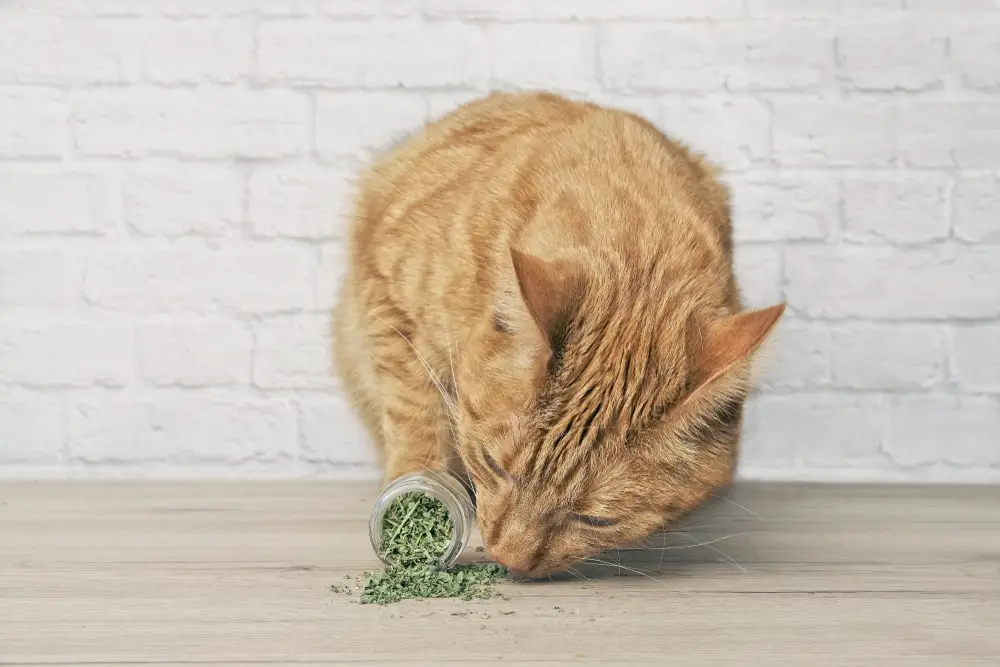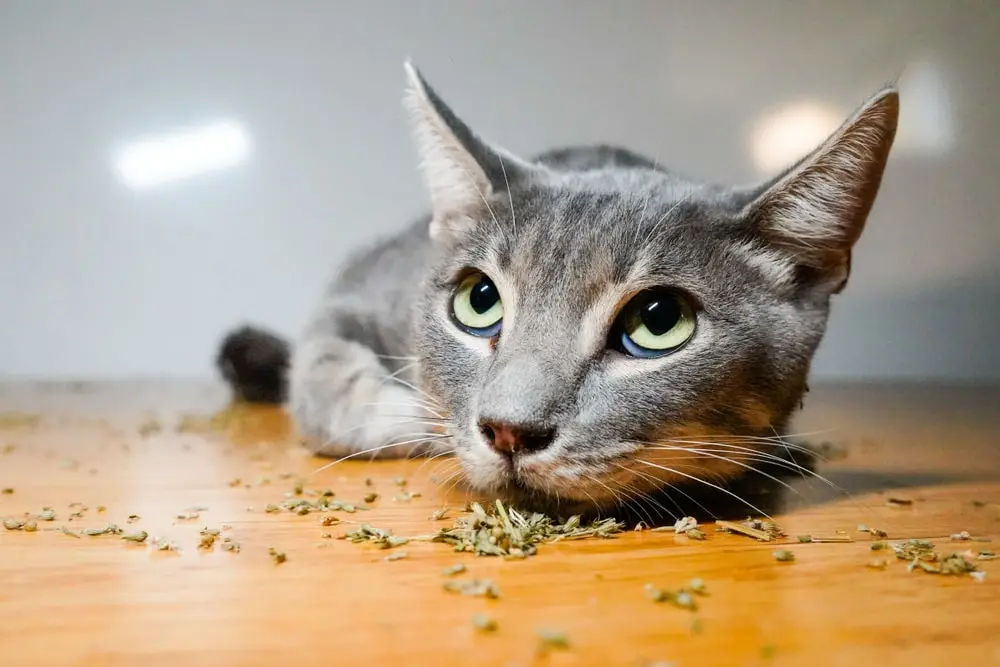PET BEHAVIOR
Sprinkling a bit of catnip on a scratching post or tossing your kitty a catnip toy can bring you and your favorite feline a lot of joy. Not only do most cats seem to enjoy the experience, but watching your pet act like a goofball can be endlessly entertaining, too.
However, despite its widespread use, how much do you know about catnip and how it helps calm (or perk up) your cat? We dug deep to help you uncover the roots of this kitty catalyst, how it works, and what veterinarians have to say about using it safely.
What Is Catnip?
Catnip (Nepeta cataria) is a leafy green plant that’s from the mint family of the plant kingdom, just like lavender and basil.1 Originally introduced as a culinary herb, catnip plants can now be found in outdoor and indoor herb gardens all over the world, as well as growing in the wild as a weed.2,3
Catnip plants produce an oil called nepetalactone. This is the chemical compound responsible for the strong response evident in most cats.1 When catnip leaves are harvested and dried, the oil becomes much more potent. This is the kind of catnip typically sold to cat parents, either as loose leaves or stuffed into cat toys. There are other ways to process catnip as well, including creating tinctures from the oil or even steeping the leaves to make an herbal tea that both cats and humans can enjoy.1,4
How Does Catnip Affect Cats?
So what does all this mean for your cat? For an explanation of catnip effects on cats, Dr. Emily Swiniarski, DVM, Chief Medical Officer of PAWS Chicago has some answers. “When most cats smell catnip, it binds to scent receptors in their nose and creates a state of arousal,” Swiniarski says. “This can lead to increased playfulness and ‘zoomies,’ but can also lead to agitation, including growling and swatting. Then, after about a half hour, the effects wear off and the cat tends to get tired and relaxed.”5
Swiniarski adds that not every cat responds to catnip the same way. “If you’re giving your cat catnip for the first time, you should watch them closely. You never know how they’ll respond, and if you have other cats, they may lash out if the catnip makes them agitated,” she cautions.
Also, it’s worth noting that not all cats are affected by catnip. Experts estimate that only 70% – 80% of cats are affected by nepetalactone, and that susceptibility to the effects of catnip is an inherited trait.3
Why Do Cats Like Catnip?
Catnip stimulates the parts of a cat’s brain responsible for emotional and behavioral responses.3 That can prompt an excited feeling of euphoria and stimulation, followed by a relaxed state of calm once the effects wear off. Generally speaking, many cats seem to enjoy the stimulating and calming effects of catnip, which could enrich their life.
“Catnip provides a unique taste, smell, and texture that activates your cat’s senses. It helps them experience their natural behaviors in a different way, which helps prevent boredom,” says Swiniarski. She adds that it’s especially useful when you have a cat who isn’t physically active, noting, “Catnip could be used to entice cats who need more exercise to move around more.”
While catnip can be a good source of pleasure and fun, Swiniarski cautions that overuse can significantly reduce its impact. In essence, your cat could build up a tolerance to the effects. “I wouldn’t use it more than once per week,” she advises. ”If cats are playing with catnip all the time, it’s not going to stimulate them.”
Benefits of Catnip for Cats
Not sure if catnip is right for your kitty? Consider these benefits:
- Used appropriately, catnip can trigger positive natural responses in some cats, including excitement, euphoria, and relaxation.
- Catnip can energize some cats, encouraging physical activity.
- Catnip may help prevent boredom by enriching a cat’s environment.
- Catnip plants offer a safe, non-toxic alternative — with some fringe benefits — for cats who tend to nibble on houseplants.
How To Give Cats Catnip
There are lots of safe ways to offer catnip to your favorite feline. These include:
- Loose, dried catnip leaves, which can be sprinkled wherever you like
- Cat toys stuffed with dried catnip
- Catnip plants, which can be grown indoors or outside
- Catnip spray
- Catnip bubbles
- Catnip treats
- Catnip tea
Dried catnip is by far the most popular option, but note that this highly concentrated form does lose its potency over time. You can extend its life by storing it in an airtight container in the freezer.6
Swiniarski recommends that pet parents offer cats a “generous pinch” or two of dried catnip. For other catnip products, follow the directions on the product label or check with your vet. And always ensure that the catnip you purchase is safe and non-toxic for cats. Some products, such as highly concentrated essential oils, are designed for human use only and may be harmful to cats.7
When Is Catnip Bad for Cats?
Though both fresh and dried catnip are considered non-toxic to cats, too much of a good thing could be harmful to their health.
“Moderation is essential. Too much catnip can lead to stomach upset,” Swiniarski says. She encourages limiting the amount of dried catnip you give your pets according to the product recommendation. However, she says that it’s fine for fresh catnip plants to remain available to your cat as they aren’t as potent.
Swiniarski recommends pet parents be on the lookout for signs that a cat may have had too much catnip, such as an upset stomach, vomiting, diarrhea, and general discomfort. If you see any of these symptoms after your cat is exposed to catnip — or any reaction that concerns you — it’s best to contact your veterinarian for advice.
Catnip can also be bad for cats when it causes aggression. “If one of your cats gets agitated on catnip, it could create issues,” Swiniarski cautions. “Especially if you have several cats and one starts acting aggressively toward the others.”
Catnip FAQs
Cats aren’t the only ones known for their curiosity. Some cat parents are just as curious as their feline friends. We’ve rounded up helpful answers to some common questions pet parents may ask about catnip.
Can cats eat catnip?
Yes, they can! They’re especially likely to nibble on the leaves of fresh catnip, but dried catnip is also safe to eat in small doses.
Can kittens have catnip?
It generally doesn’t hurt kittens, but catnip likely won’t affect them until they’re between 3 – 6 months old.8
Can cats overdose on catnip?
It’s highly unlikely for a cat to ingest a fatal amount of catnip. However, they can eat so much that they get sick with an upset stomach, vomit, or have diarrhea.
Can cats get addicted to catnip?
No, but they can get used to it which can weaken their response to it. Swiniarski recommends giving catnip as a treat about once a week to allow them to enjoy it without reducing its impact.
Is catnip bad for dogs?
When it comes to dogs and catnip, there’s little need to worry. Catnip is non-toxic to dogs, so even if your dog ingests some, it shouldn’t be a problem. However, eating a large quantity of dried or fresh catnip could cause your pup gastrointestinal distress, such as vomiting or diarrhea.
Consider Investing in Pet Insurance
Catnip can be a fun treat for your four-legged friend, but like all good things, moderation is key. You may find that your cat develops an upset stomach and shows symptoms from consuming too much catnip. This could lead to an unexpected trip to the vet and a bill along with it.
Cat insurance from MetLife Pet may be able to help. We can reimburse you for covered expenses associated with illnesses like stomach upset or injuries.9 Get a free quote today to see if MetLife Pet Insurance is right for you and your cat.


